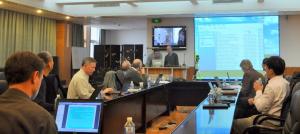Wrap it, roll it and sign it off
In January this year, a ground-breaking ceremony took place at Nippon Steel Engineering (NSE), a steel production plant situated in Kita-Kyushu, on the northern tip of the Japanese island of Kyushu. NSE was selected by the Japanese Domestic Agency to carry out the jacketing of its share of conductors for ITER's toroidal field coils and the central solenoid.
The conductors for the ITER magnets are made of a rope-type cable inserted into a conduit along which circulates a forced flow of supercritical helium. The conduit itself is made up of seamless tubes which are butt-welded together. It is assembled straight on a so-called jacketing line. After cable insertion into the conduit, the assembly is compacted to the final conductor dimension and spooled for transportation to the coil winding site.
This summer, NSE completed the civil engineering of the 950-metre-long facility; since then, the company has been installing and commissioning the required equipment, including welding and welding inspection tools, a winch for cable insertion and compaction, spooling, and local and global helium testing equipment.
Before shipment, the conductor undergoes various acceptance tests, including helium pressure and leak tests in a vacuum tank. At present, NSE together with the Japanese Domestic Agency are clearing the qualification procedure hold points and have received the green light from the ITER Organization to start welding their first, 760-metre-long toroidal field jacket assembly. This conduit will be used for the jacketing of a dummy cable made of copper, already produced by Hitachi to complete the validation of the conductor manufacturing process.
The first jacketing will take place early January 2010 and will mark another milestone in the launching of conductor production, which Japan has been actively leading since the signature of the Toroidal Field Conductor Procurement Arrangement in November 2007.
First components pass "Authorization-to-Proceed" check
Acceptance testing and quality control is not only obligatory for the jacketing manufacturing procedure, but also for the conductor itself. Especially due to the fact that the fabrication of ITER's superconducting magnets will take place in different locations around the world, the implementation of a tight quality assurance and quality control plan involving the Domestic Agencies and their suppliers is crucial to insure that all conductors meet the same technical requirements.
This plan includes a procedure for issuing "Authorization-to-Proceed" (ATP) clearances at key steps of the suppliers' manufacturing processes. The clearances are granted by the Domestic Agencies, who notify the ITER Organization. If there is no objection to the ATP clearance, the work can proceed to the next manufacturing step. The clearances are granted by the ITER Organization on the grounds of acceptance requirements which are clearly defined in the Procurement Arrangements. The whole process is handled electronically through the ITER-developed Conductor Database.
The Japanese and the Korean Domestic Agencies have recently cleared their first ATP points: Japan passed the check for the production of a 760-metre copper cable required for qualifying their cabling process; while Korea produced 14 niobium-tin (Nb3Sn) strand billets (about 0.6 tonnes) for their first superconducting cable length. These are the first ITER-relevant components to go through the ATP process, marking another critical milestone in the manufacturing of ITER conductors.
Three reviews in one flap
And there is more progress on the magnets front. In an intensive week, taking best possible advantage of the availability of experts from China and external institutes, ITER's magnet division organized three final design reviews, hosted by the Institute of Plasma Physics at the Chinese Academy of Sciences (ASIPP) in Hefei.
The first review was dedicated to the supports of the toroidal and poloidal field coils and the correction coils. The review panel was chaired by Pierre Védrine from CEA. The second panel focusing on the conductor for the correction coils was chaired by Reinhard Heller from the Forschungszentrum Karlsruhe in Germany. The third review, addressing the correction coils themselves, was chaired by Elwyn Baynham from the Rutherford Appleton Laboratory.
The 18 correction coils are grouped by pairs and inserted between the toroidal and the poloidal field coils. Their role is to compensate the magnetic error fields resulting from coil misalignment and tolerances. They use a 10 kA niobium-titanium alloy (NbTi) conductor very similar to that used in the coils of the Chinese tokamak EAST, and it is planned that both the conductor and the coils will be delivered by China. The reviews were organized at Hefei at close distance from the place where the conductor will be jacketed and the coils wound. The jacketing line in Hefei is near completion and will be also used to jacket China's share of the conductors for ITER's toroidal and poloidal field coils as well as the feeders. As there were no showstoppers identified in the review meetings, the road is paved towards the signature of the Procurement Arrangements for both the correction coil conductor and the correction coil itself—both scheduled for early 2010.




